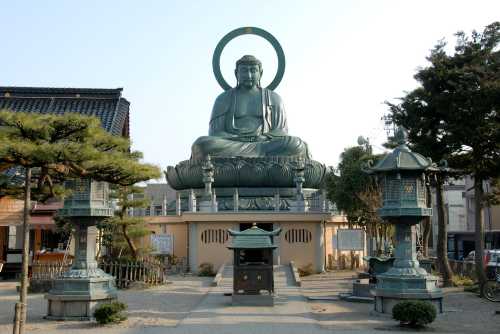Popular Trip Moments
🌊🚉【Toyama - Roadside Station Amaharashi】 | Rainy晴 Coastline, Majestic Sea Views Along the Himi Line | 🌊 I thought Izu was already breathtaking, until I discovered Amaharashi Coast ☀️ | 🚂Amaharashi Coast จุดชมวิวเจแปนแอลท์สุดสวย | Izakaya Takamasa: Takaoka City, Toyama Prefecture | 富山縣高岡市 - 哆啦A夢景點 | [Toyama] Day trip! | [Toyama Prefecture] Iwasakinohana Lighthouse: A hidden gem of a lighthouse offering a panoramic view of Toyama Bay | 4-Day Japan Tour: A Super Detailed Guide You Must Save | 8-Day Tour in Japan | Romantic Spring Itinerary | 4-day in-depth tour of Japan 🔥 A big reveal of the tips for WeChat Moments | 8-Day In-Depth Tour of Japan: A Super Detailed Guide Awaits | Toyama, Japan|Missed a word! | 2-Day Toyama Prefecture Itinerary: Capture Stunning Snowy Mountain Views | Toyama: Discover a Hidden Gem in Japan | Who knew Doraemon's hometown was so beautiful? | Takaoka Great Buddha, 16 meters tall, made of bronze, one of the three largest Buddha statues in Japan | Zuiryuji Temple, the only national treasure-level Zen temple in Toyama Prefecture | I thought Kamakura was beautiful enough, until I came to Amaharashi Coast. | 7-Day Japan Trip: A Super Detailed Guide, No Regrets | 8-Day Japan Itinerary: Explore the Entire Country | [Takaoka Great Buddha: Takaoka City, Toyama Prefecture] | He is also known as "the most handsome man in Japan" | This is one of only three beaches in the world where you can see 3,000m-high mountains across the sea. | Go to Takaoka City and take the Doraemon Train | [Toyama] Takaoka, a city where history and culture live on | [Yoshitsune Rock] A mysterious rock where legends live on | Japan's Hidden Coastal Gem That Outshines Kamakura! | 7-Day Trip to Japan: Your Ultimate Guide
Recommended Attractions at Popular Destinations
Bangkok attraction near me | Manila attraction near me | Tokyo attraction near me | Taipei attraction near me | Hong Kong attraction near me | Seoul attraction near me | Kuala Lumpur attraction near me | Los Angeles attraction near me | Shanghai attraction near me | New York attraction near me | Shenzhen attraction near me | Osaka attraction near me | Singapore attraction near me | London attraction near me | Guangzhou attraction near me | San Francisco attraction near me | Beijing attraction near me | Macau attraction near me | Bali attraction near me | Jakarta attraction near me | Paris attraction near me | Ho Chi Minh City attraction near me | Istanbul attraction near me | Phuket attraction near me | Chicago attraction near me | Seattle attraction near me | Toronto attraction near me | Orlando attraction near me | Cebu attraction near me | Chiang Mai attraction near me
Popular Attractions
Zayed National Museum | Bund Sightseeing Tunnel | Ubud Palace | Dubai Parks and Resorts | Dubai Frame | Kanifinolhu | Xichong | Snow Abu Dhabi | SeaWorld® Yas Island | Atlantis the Palm, Dubai | Sun Yat Sen Museum Penang | Alhambra | Sa Pa | Palace of Versailles | Tashkent Botanical Garden Named After Academician F. N. Rusanov | Sheikh Zayed Desert Learning Centre | Royal Caribbean International | University Rose Garden | Amfibius Aquapark | Cine Teatro Cervantes | HSS Engineers Berhad | Hinodemachi Park | St. Patrick's Roman Catholic Church | Vision library | Parc de la Pointe | Woodman Recreation Area | Oxford Community Arts Center | Stadion | Art Gallery Renoir | View of Alefkandra (Little Venice)
Popular Restaurants in Takaoka
OHANA | CAFE & DINING COO | TOP RESTAURANT FOUR SEASONS | Ahora Aqui | Izakaya Takamasa | Makotoya | Ramen Jigen | Yoshimune | Hachiban Ramen Tode | Shimizutei | Anshin Gohan | Sankaitei | soup curry maruna | Towari Soba Noan | Yakiniku No Barns Yotsuya | DOCG | Restaurant le Premier | Wasaiko Kirari | Yasuragian | Tontei | Wakana Sushi | House Roast Coffee and Western Dishes Crown | Merry Smile Cafe | Sushi Kan | Gyosanjin | Sushi Izakaya Takazin | Mister Donut Aeon Malltakaoka | Ramen no Shoryu | Daicho | Sushikin
Popular Ranked Lists
Popular Must-Visit Restaurants in Songyang | Popular Premium Hotels in Faisalabad | Popular Must-Visit Restaurants in Singapore | Popular Best Things to Do in Pennington County | Top 15 Local Restaurants in Kuala Lumpur | Popular Luxury Hotels Near Diani Beach | Popular Luxury Hotels in Quetta | Top 19 Light Bites in Singapore | Popular Must-Visit Restaurants in Ho Chi Minh City | Popular Best Things to Do in Otero County | Popular Best Things to Do in Ningming | Popular Local Restaurants in Xi'an | Top 3 Best Things to Do in Pamukkale | Popular Local Restaurants in Bali | Popular Must-Visit Restaurants in Dalat | Popular Local Restaurants in Shanghai | Popular Best Things to Do in Suffolk County | Popular Best Things to Do in Ozaukee County | Popular Must-Visit Restaurants in Hong Kong | Popular Must-Visit Restaurants in Hanoi | Top 20 Local Restaurants in Dubai | Top 20 Local Restaurants in Nanjing | Popular Best Things to Do in Broward County | Popular Best Things to Do in Sandusky | Popular Must-Visit Restaurants in Seoul | Popular Luxury Hotels in Balochistan | Popular Premium Hotels in Karbala | Popular Must-Visit Restaurants in Dubai | Popular Best Things to Do in Changting | Top 3 Best Things to Do in Jerusalem District
Payment Methods
Our Partners
Copyright © 2025 Trip.com Travel Singapore Pte. Ltd. All rights reserved
Site Operator: Trip.com Travel Singapore Pte. Ltd.
Site Operator: Trip.com Travel Singapore Pte. Ltd.






















